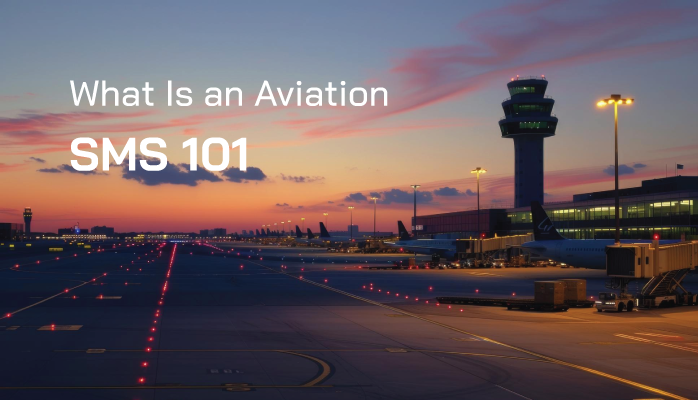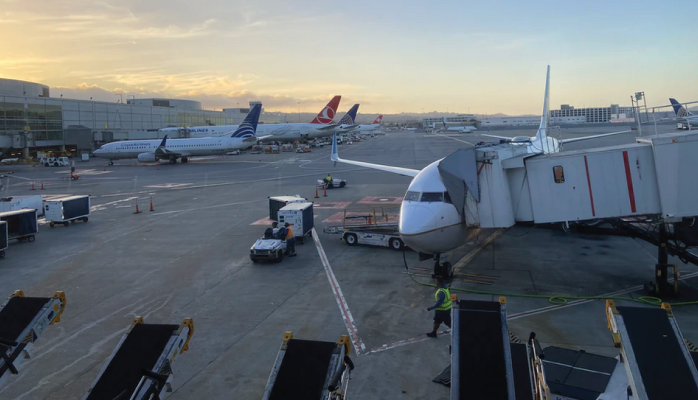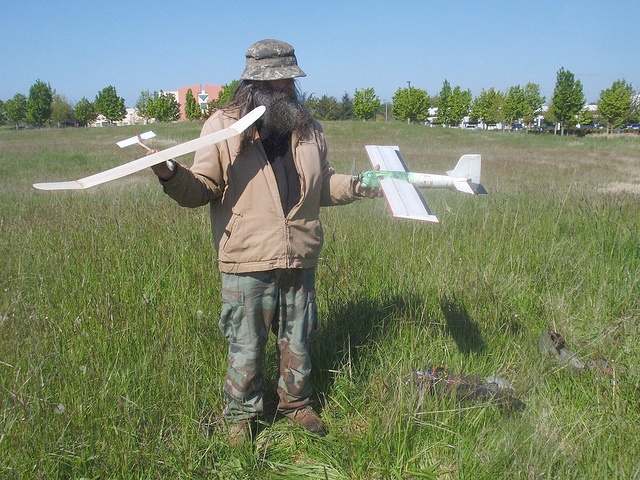Brief Definition of Aviation SMS for the Layman

Some of you are well acquainted with the ins and outs of aviation safety management systems and SMS software.
If you are in the other group, like me, and are only barely acquainted with what aviation SMS is and who uses it, then this article is for you.
Before we jump in, let’s set some groundwork for what SMS is.
A safety management system is exactly what it sounds like: A structured, standardized, and systematic approach towards integrating hazard-reducing practices in the work environment, promoting awareness of safe decision-making processes, and cultivating an attitude of safety at every level of an organization.
The Federal Aviation Administration (FAA) notes that
To meet the requirements of the aviation industry on a global level, SMS is an essential and critical part of your organization’s risk management process.
Aviation SMS programs are built on what is known as the Four Pillars:
These four components are the recognized foundation of an SMS program.
Related Articles on Aviation SMS Four Pillars
- What Are the 4 Pillars of SMS?
- Who Started Four Pillars of Safety Management in Aviation?
- Which of the Four Pillars of SMS Carries the Most Weight?
SMS in the Aviation Industry and Beyond
ICAO has mandated that SMS becomes the worldwide standard in the aviation industry. For example, the Federal Aviation Administration (FAA) talks in great detail about SMS as they follow the ICAO guidelines; they note that
To meet the requirements of the aviation industry on a global level, SMS is an essential and critical part of your organization’s risk management process.
In addition to the FAA, other international authorities and civil aviation authorities promulgate SMS, such as:
- Transport Canada,
- International Air Transport Association (IATA);
- U.K Civil Aviation Authority;
- International Business Aviation Council (IBAC).
The list of SMS endorsing agencies is extensive, but the above list should give you a good idea of just how important aviation SMS has become to the aviation culture.
Other industries beyond aviation have begun to adopt SMS programs as well, including:
The adoption of SMS principles and risk management processes should come as no surprise. Every work environment has potential hazards. The fact that SMS and similar systems have begun to be adopted in other industries is a testament to the success of SMS in effective Risk Management.
Different SMS for Different Companies
One of the things that initially confused me about SMS was whether or not the SMS standards were universally the same among different companies and aviation industry segments. In other words:
→ Could Airline A adopt different safety standards than Airline B?
→ Do commercial airliners (FAR part 121) and charter aircraft (FAR part 135) have the same SMS standards?
The answer is yes and yes. SMS risk management processes and methodologies will differ from company to company and industry segment to industry segment. And for good reason.
While safety practices, for the most part, are fairly universal – such as keeping the work environment clean and organized - each company and industry segment will
- have unique needs;
- be exposed to different hazards;
- elect to implement different risk controls;
- enjoy (or suffer) from various types of safety culture;
- possess unequal access to technologies to manage safety, including personnel capabilities and SMS database technologies;
- differ in ability to attract capital and access to markets; and
- face differing levels of scrutiny from SMS auditors.
Therefore, the SMS from each company will require a custom-tailored aviation SMS based on the size and complexity of their operations.
Aviation service providers may tailor their SMS risk management processes towards reducing unsafe practices regarding:
- Debree, potholes, and damage on the runway;
- Fatigue and working hours for pilots;
- Thoroughness of engine checks.
Related Aviation Risk Management Articles
- Difference Between Reactive, Predictive and Proactive Risk Management in Aviation SMS
- From Reactive to Proactive Risk Management in Aviation SMS
- Going From Reactive to Predictive Risk Management in Aviation SMS
Aviation SMS Acceptance Is Often Not Willing

But whereas a commercial airline’s SMS may have a strong focus on passenger policies/safety, a smaller charter operator may have more focus on weather-condition operations, and another operator may focus their risk mitigation strategies around cockpit safety. Every operator is unique and their key performance indicators (KPIs) or safety performance indicators (SPIs) may also be unique to their operation.
An aviation SMS is not a "one-size-fits-all" approach. This may be a reason for confusion arising from SMS implementations. Aviation SMS principles are industry-segment agnostic. The safety risk management (SRM) and safety assurance (SA) processes remain the same. SMS is a technology. SMS is a process that works regardless of which industry segment you operate in. Yet while the processes remain the same, practicing risk management using SMS processes will not be performed with similar fervor and efficacy across the industry, or across different regions of the world.
One thing we can be assured of is that resistance to this forced change occurs in all industry segments and companies of all sizes. Humans don't like change, especially when they have developed habits that "seem to work." This becomes more obvious with the older generation of employees who have considerable operational experience. These employees know what works for them, and become apprehensive in that:
- they have to learn something new that may make them appear incompetent; or
- their daily duties keep them so occupied, they don't have time to entertain another way of doing their jobs.
Many upper-level managers have production quotas or level of service expectations. The idea of maintaining operations at the existing level while also "changing" the way business is performed fills them with uncertainty. Uncertainty breeds resistance. Resistance breeds resentment. Resentment breeds apathy and underperforming safety cultures.
Related Aviation Safety Culture Articles
- What Is Safety Culture in the Aviation Industry?
- 6 Signs of a Mature Aviation Safety Culture - With Resources
- 6 Types of Safety Culture in Aviation Safety Management System
Aviation SMS Is a System Requiring All Four Pillars
While safety culture is an important element of effective aviation SMS, SMS is a system requiring adequate attention to ALL four pillars. When you remove any of the four pillars, the system does not function.
For each organization with an SMS, a safety policy establishes
- accountabilities;
- responsibilities; and
- policies and procedures.
Safety risk management (SRM)focuses on:
- hazard identification;
- risk analysis and assessments; and
- establishing effective risk controls.
Safety assurance provides operators the assurance that their system design (SRM) is performing as intended. Main activities in safety assurance include:
- safety reporting;
- auditing; and
- monitoring SMS performance.
Safety promotion is equally important, but not stressed enough. Safety promotion "promotes" safe operating cultures through:
- SMS training; and
- Varied safety communication strategies all aimed to increase awareness and participation in the SMS.
Performing and regulatory-compliant SMS focuses on all four pillars, but their activities and processes may be unique. There is no "one-size-fits-all SMS." Furthermore, complex organizations also have different operational risk management protocols (or operational risk profiles) for each of their divisions, i.e., flight ops, maintenance crew, ground handling, etc. Activities to monitor risk and manage risk may be different, but the risk management processes at a high level remain the same.
Move out into a different industry, such as healthcare, and I’m sure you can imagine that they have a whole different set of risk management strategies; however, the structure will probably look very familiar.
So the primary takeaway is that SMS programs are universal in their drive for continuous safety improvements, but more industry/company-specific in exact practices and focus.
Related Articles on Aviation SMS Continuous Improvement
- What Continuous Improvement Compliance Looks Like in Real SMS
- How to Be Compliant With Continuous Improvement of SMS
- 4 Pillars | The Truth About SMS Continuous Improvement and KPIs - With Free KPI Resources
Individuals Who Participate in Aviation SMS

This one is easy. Anyone and everyone can be involved in aviation SMS. That’s the point.
- An FAA Safety Inspector will probably be very concerned that the company he/she oversees adopts the most appropriate level of detail and follows through with the best, most compliant practices;
- A Department Head or CEO will be very familiar with his/her SMS in order to ensure that his/her employees and work environments are compliant with regulatory requirements and best practices;
- All employees who are part of an SMS will ideally be aware of their company's aviation SMS so that they may both reactively and proactively report hazards when they arise.
- Accountable executives are responsible for ensuring the SMS is properly implemented and performing in all areas of the organization. Furthermore, with assistance from the safety team, they must monitor SMS performance regularly to detect shortcomings and address identified substandard safety performance.
Anywhere there are hazards, there is an opportunity to mitigate risk using the best practices of their aviation SMS.
Difference Between Aviation SMS and Aviation Safety Program
The FAA has been making a push in the past five years or so to differentiate traditional safety programs from aviation SMS. Their arguments that aviation safety programs are not structured, top-down business approaches to managing safety. Do not be shocked to hear adamant safety inspectors complain when you say "SMS program" instead of SMS.
Aviation safety programs have been in existence for decades, and I believe the FAA stance is meant to change attitudes and culture toward SMS. Instead of preaching the same old sermon, the FAA wants to show people that aviation SMS is better than traditional safety programs. It is true that aviation SMS does not equate to traditional safety programs. For one, there are identified standards and processes to manage hazards, risks, and control measures.
In addition to standardized safety risk management (SRM) and safety assurance (SA) processes, aviation SMS is legitimized with the expected active participation from upper management, which is not seen in most aviation safety programs. There are terms like accountability, responsibility, and authority used in aviation as they relate to "documented processes" in the management of safety and the monitoring of safety performance.
Besides accountable executive "accountability" and expected participation in the aviation SMS, other factors may differentiate an aviation SMS from traditional safety programs. These may include:
- Just culture with a non-punitive reporting policy to protect employees from management actions when "self-reporting" errors or mistakes versus no protection;
- Employees increase reporting due to protections versus reporting only when there is no chance of being discovered, such as anonymous reporting;
- Safety is a core business process instead of merely being an isolated "department;"
- Focus on developing a safety culture to stimulate active hazard identification and a safety reporting culture, versus the belief that employees will simply report accidents and incidents after they have occurred.
Related Articles on Safety Accountability in Aviation SMS
- Distinguishing Between Responsibility, Authority, and Accountability in Your Aviation SMS
- 5 Steps to Define Accountabilities in Aviation SMS
- 3 Scenarios Accountable Executives Need to Minimize Risk to Aviation SMS
Final Thoughts
SMS is not a tricky subject, nor does it involve complex risk management processes. It involves similar practices toward achieving the result of continuous safety improvement. However, to assess exactly what is aviation SMS, you would have to look at a specific industry segment – part of the industry, company, or division. In other words, auditing an aviation SMS can focus on both the high-level general elements and specific details at the department level, such as:
- Hazard identification and safety reporting metrics;
- Safety promotion activities; and
- SMS training.
Another misconception about aviation SMS compared to traditional safety programs is that safety reports and documentation can be managed in spreadsheets or disparate point solutions. We commonly see operators struggle early in their SMS implementations because they failed to understand the SMS documentation requirements and adopted inadequate SMS data management strategies.
An SMS, by its name, is a system. You will also need an integrated data management system to pull all four pillars together to effectively monitor SMS performance, detect trends, and measure safety culture. Fortunately, I've worked with hundreds of companies as we provided them with SMS data management capabilities. Unfortunately, I've also seen scores of failed S MS implementations.
Software is inexpensive. Labor is expensive. A company may spend $10,000 for a week of SMS training or $10,000 for an entire year for using an SMS database solution. Which adds more value? Can you have both? Some SMS software comes with step-by-step training videos that not only train employees on the SMS software but also on SMS best practices.
Another cost-benefit analysis may be required if you are considering hiring an SMS consultant who may leave your company within a few days to a few weeks. The consultant may leave you with spreadsheets that may accomplish a particular task such as:
- Hazard register;
- Risk management template for reported safety issues.
These spreadsheets end up becoming a hindrance to the SMS by years two and three of the SMS implementation. An SMS database is required to properly manage an aviation SMS. The Europeans (EASA) recognized this years ago and now require operators to use a database to store safety reports.
If you are starting an aviation SMS implementation, I recommend getting an SMS database from the beginning to document all SMS activities. SMS Pro comes with gap analysis tools as well as an SMS manual template that aligns with SMS Pro's risk management processes.
Process to Start Using SMS Pro Database Software
To see how you can benefit from SMS database software, please watch these short demo videos. If we seem like a good fit for you, sign up for a live demo to ask any questions or determine the next steps.
Live SMS Pro Demo
Have questions? Sign up for a live demo below:
Last updated July 2025.
Trash Aviation Founder, Jim Boatscum image by Carl Paulaner Hefe-weizen on flickr









